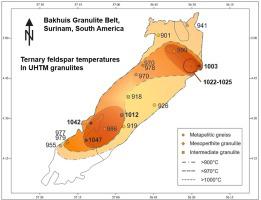当前位置:
X-MOL 学术
›
Precambrian. Res.
›
论文详情
Our official English website, www.x-mol.net, welcomes your
feedback! (Note: you will need to create a separate account there.)
Regional UHT metamorphism with widespread, primary CO2-rich cordierite in the Bakhuis Granulite Belt, Surinam: a feldspar thermometry study
Precambrian Research ( IF 3.2 ) Pub Date : 2020-11-01 , DOI: 10.1016/j.precamres.2020.105894 Josefine A.M. Nanne , Emond W.F. de Roever , Karlijn de Groot , Gareth R. Davies , Fraukje M. Brouwer
Precambrian Research ( IF 3.2 ) Pub Date : 2020-11-01 , DOI: 10.1016/j.precamres.2020.105894 Josefine A.M. Nanne , Emond W.F. de Roever , Karlijn de Groot , Gareth R. Davies , Fraukje M. Brouwer

|
Abstract A metapelite area in the Paleoproterozoic Bakhuis Granulite Belt (BGB) in western Surinam shows mineral assemblages diagnostic of ultrahigh-temperature metamorphism (UHTM): high-Al orthopyroxene + sillimanite + quartz and sapphirine + quartz. Metapelites elsewhere in the belt contain cordierite + sillimanite. Locally associated high-Al orthopyroxene might indicate that the cordierite + sillimanite assemblage was formed by UHTM. The Mg-rich cordierite has an elevated birefringence, up to blue second order, which is evidence for a considerable amount of CO2 in its lattice. Given the absence of a reliable model for CO2-bearing cordierite, phase equilibrium modelling cannot be applied to determine the metamorphic conditions of these rocks. Instead, ternary feldspar thermometry, using the Fuhrmann and Lindsley model, was applied to mesoperthite and antiperthite in 25 samples of mainly metapelite throughout the BGB. The temperatures determined range between 900 and 1050 °C. The temperatures are minimum estimates for the metamorphic temperature because the feldspar crystallized upon cooling from melts generated during peak metamorphism. These results imply that most of the BGB witnessed UHT metamorphism and that the widespread assemblage cordierite + sillimanite ± high-Al orthopyroxene indeed formed under UHTM conditions. The widespread formation of primary cordierite is unusual for UHTM terranes and is probably the result of its considerable CO2 content.
中文翻译:

苏里南 Bakhuis 花岗岩带中分布广泛的富含原生 CO2 堇青石的区域 UHT 变质作用:长石测温研究
摘要 苏里南西部古元古代 Bakhuis 花岗岩带 (BGB) 的变泥岩区显示出具有超高温变质作用 (UHTM) 诊断特征的矿物组合:高铝斜方辉石 + 硅线石 + 石英和蓝宝石 + 石英。带中其他地方的变质泥岩含有堇青石 + 硅线石。局部相关的高铝斜方辉石可能表明堇青石 + 硅线石组合是由 UHTM 形成的。富含镁的堇青石具有较高的双折射,高达蓝色二阶,这证明其晶格中含有大量 CO2。由于缺乏含 CO2 堇青石的可靠模型,相平衡模型不能用于确定这些岩石的变质条件。相反,三元长石测温,使用 Fuhrmann 和 Lindsley 模型,应用于整个 BGB 的 25 个主要为变泥质岩的样品中的中钙长石和反长石。确定的温度范围在 900 到 1050 °C 之间。这些温度是变质温度的最低估计值,因为长石在从峰值变质过程中产生的熔体冷却时结晶。这些结果意味着大部分 BGB 见证了 UHT 变质作用,并且广泛的组合堇青石 + 硅线石 ± 高铝斜方辉石确实在 UHTM 条件下形成。原生堇青石的广泛形成对于 UHTM 地体来说是不寻常的,这可能是其大量 CO2 含量的结果。这些温度是变质温度的最低估计值,因为长石在从峰值变质过程中产生的熔体冷却时结晶。这些结果意味着大部分 BGB 见证了 UHT 变质作用,并且广泛的组合堇青石 + 硅线石 ± 高铝斜方辉石确实在 UHTM 条件下形成。原生堇青石的广泛形成对于 UHTM 地体来说是不寻常的,这可能是其大量 CO2 含量的结果。这些温度是变质温度的最低估计值,因为长石在从峰值变质过程中产生的熔体冷却时结晶。这些结果意味着大部分 BGB 见证了 UHT 变质作用,并且广泛的组合堇青石 + 硅线石 ± 高铝斜方辉石确实在 UHTM 条件下形成。原生堇青石的广泛形成对于 UHTM 地体来说是不寻常的,这可能是其大量 CO2 含量的结果。
更新日期:2020-11-01
中文翻译:

苏里南 Bakhuis 花岗岩带中分布广泛的富含原生 CO2 堇青石的区域 UHT 变质作用:长石测温研究
摘要 苏里南西部古元古代 Bakhuis 花岗岩带 (BGB) 的变泥岩区显示出具有超高温变质作用 (UHTM) 诊断特征的矿物组合:高铝斜方辉石 + 硅线石 + 石英和蓝宝石 + 石英。带中其他地方的变质泥岩含有堇青石 + 硅线石。局部相关的高铝斜方辉石可能表明堇青石 + 硅线石组合是由 UHTM 形成的。富含镁的堇青石具有较高的双折射,高达蓝色二阶,这证明其晶格中含有大量 CO2。由于缺乏含 CO2 堇青石的可靠模型,相平衡模型不能用于确定这些岩石的变质条件。相反,三元长石测温,使用 Fuhrmann 和 Lindsley 模型,应用于整个 BGB 的 25 个主要为变泥质岩的样品中的中钙长石和反长石。确定的温度范围在 900 到 1050 °C 之间。这些温度是变质温度的最低估计值,因为长石在从峰值变质过程中产生的熔体冷却时结晶。这些结果意味着大部分 BGB 见证了 UHT 变质作用,并且广泛的组合堇青石 + 硅线石 ± 高铝斜方辉石确实在 UHTM 条件下形成。原生堇青石的广泛形成对于 UHTM 地体来说是不寻常的,这可能是其大量 CO2 含量的结果。这些温度是变质温度的最低估计值,因为长石在从峰值变质过程中产生的熔体冷却时结晶。这些结果意味着大部分 BGB 见证了 UHT 变质作用,并且广泛的组合堇青石 + 硅线石 ± 高铝斜方辉石确实在 UHTM 条件下形成。原生堇青石的广泛形成对于 UHTM 地体来说是不寻常的,这可能是其大量 CO2 含量的结果。这些温度是变质温度的最低估计值,因为长石在从峰值变质过程中产生的熔体冷却时结晶。这些结果意味着大部分 BGB 见证了 UHT 变质作用,并且广泛的组合堇青石 + 硅线石 ± 高铝斜方辉石确实在 UHTM 条件下形成。原生堇青石的广泛形成对于 UHTM 地体来说是不寻常的,这可能是其大量 CO2 含量的结果。











































 京公网安备 11010802027423号
京公网安备 11010802027423号